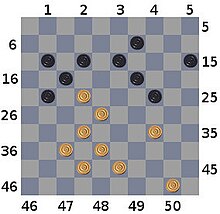Lady's notation
The Lady notation is used for recording and analyzing Dame games and is common especially in the area of international tournaments. There are different types of game notation , depending on the specific queen variant and the purpose of writing.
The notation used primarily in German checkers and other variants on the classic chess board with 64 fields is the adoption of chess notation . In the case of the Polish checkers with 100 fields, which is common in tournaments , a notation predominates in which the fields are numbered. A single queen position or a single move can be represented in the literature by a diagram.
Classic ladies notation
Especially in the English-speaking countries where drafts or checkers are played, as well as in tournament games of the 10-field checkers ( Polish checkers ) and the 12-field checkers ( Canadian checkers ), a notation that differs from chess is used. Here the black squares are numbered, starting with the first square to the right of the black player (top left from the view of the white player), which corresponds to b8 in chess notation. In the 8-field game (German checkers, drafts, tournament lady 8 × 8) black begins the game on fields 1 to 12 and white on fields 21 to 32, in a 10-field game (Polish checkers, tournament lady 10 × 10 ) Black starts on 1 to 15 and white on 36 to 50.
Moves are noted in such a way that the start and finish fields are given as numbers (e.g. 21-17). This also applies when a stone is struck; a move 21-14 means that a piece has moved from field 21 to field 14 and captured the opposing piece on field 17. This notation is also used for multiple jumps and jumps with the queen. In order to store the striking in the notation, there is also the option to use a × or a: and ex. 21 × 14 to be noted. Multiple jumps can be noted in this form either individually (e.g. 39 × 28 × 17 × 8 × 19) or together (39 × 19).
Chess notation
| a | b | c | d | e | f | G | H | ||
| 8th | 8th | ||||||||
| 7th | 7th | ||||||||
| 6th | 6th | ||||||||
| 5 | 5 | ||||||||
| 4th | 4th | ||||||||
| 3 | 3 | ||||||||
| 2 | 2 | ||||||||
| 1 | 1 | ||||||||
| a | b | c | d | e | f | G | H |
Especially in German-speaking countries, the checkers game is documented on a chessboard with 64 fields and the rows and columns are named according to the chess notation. The notations are designed according to a matrix in which the columns are designated from left to right from A to H and the rows from bottom to top from 1 to 8, as seen by the white player . For the 10-square queen, this can be extended by two more columns (I, J) and two more rows (9, 10). A space is called a combination of letter and number according to its coordinate, and moves are noted so that the starting and ending spaces are indicated.
Number coordinates
Another variant is a hybrid version of the classic chess and queen notation. In this case, like the chessboard, the checkerboard is divided into columns and rows along the edges; however, both are counted with numbers starting at the top left (from white). In this case, field 1/2 corresponds to field b8 in chess notation or field 1 in classic queen notation. Moves are also noted here in such a way that the start and finish fields are indicated (e.g. 3/6 - 4/5).
Computer notation
The computer notation for Dame / Drafts is derived from the classical ladies notation and stored in a format called Portable Drafts Notation .
supporting documents
- ↑ a b c d e Claus D. Grupp: Lady. The board game in all variations. Falken-Verlag and ASS Spiele, Leinfelden 1979. ISBN 3-8068-2028-7 ; Pp. 17-20.
- ↑ a b The Numbered Board and Move Notation. The Checker Maven; accessed on April 3, 2020.
- ↑ a b International Drafts tutorial p.2. Notation on bonaludo.com
literature
- Claus D. Grupp: Lady. The board game in all variations. Falken-Verlag and ASS Games, Leinfelden 1979. ISBN 3-8068-2028-7
Web links
- International Drafts tutorial p.2. Notation on bonaludo.com
- The Numbered Board and Move Notation. The Checker Maven

